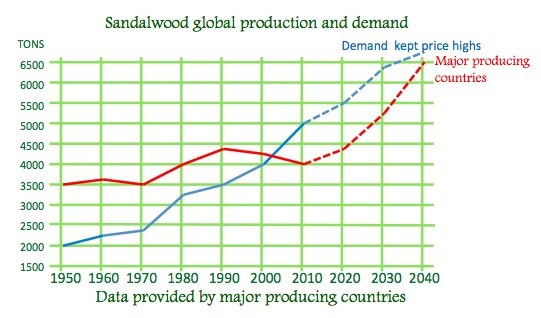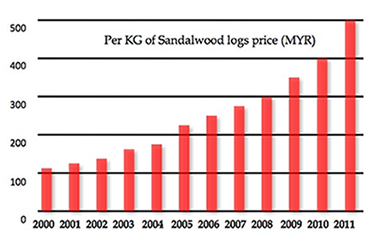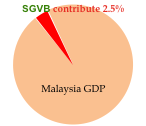| The Costing Per Acre | ||
| Plant | MYR 300.00 x 435 = | MYR 130,500.00 |
| Host plants | MYR 25.00 x 435 = | MYR 10,875.00 |
| Planting cost (Including soil workings, Pits @ MYR15.00 each) | MYR 6,275.00 | |
| Cost of drip irrigation | MYR 25,000.00 | |
| Fencing | MYR 2,000.00 | |
| Annual weeding & soil work for 12 years | MYR 300.00 x 12 = | MYR 3,600.00 |
| Irrigation | MYR 200.00 x 12 = | MYR 2,400.00 |
| Fertilization | MYR 1,200.00 x 12 = | MYR 14,400.00 |
| Security & vigilance | MYR 2,400.00 x 12 = | MYR 28,800.00 |
| Total Expenses | MYR 223,850.00 |
Sandalwood Heart Wood expected yield at the age of Fifteen years after taking 30% as Motilities, Thefts etc.
| No of sandalwood trees eligible for extraction, | 300 trees |
| Quantity of heart wood expected per tree-10 kgs, total | 4,500 kgs |
| Average cost of sandalwood heart wood, MYR 500.00 | MYR 2,250,000.00 |
| Total Expenditure incurred per acre | MYR 223,850.00 |
| Average 25% land can be used, so land & other infrastructures per acre | MYR 60,000.00 |
| Net Profit would be more or less | MYR 1,966,150.00 / Acre |

Sandalwood trees are widely used by so many countries all over the world. However due to excessive deforestation and ecological environment protection, which caused sharp drop in global natural sandalwood supply. India the one time world largest exporter of sandalwood is now totally banning export of sandalwood. This further caused greater shortage of sources, and the international price of sandalwood has risen dramatically.
China, USA, France, Russia, The Middle East, Japan And so on. Europe and America have probably occupied 75% of the world supply. China yearly imports more than ten billion ringgit of sandalwood from oversea for its perfume and medicinal use. We can foreseen the international market is HUGE, it is a great opportunity for investment in sandalwood plantation.

The International market price for sandalwood has been rising dramatically. In year 2004, each kilogram was worth RM170. In 2005 each kilogram was sold at RM 236 and in 2008 the market price was RM 300 per kilogram.
A well grown sandalwood tree after 10 years may harvest for 125 kilogram of lumber or 100 kilogram of heartwoods. Base on the present market price sandalwood lumber is sold at conservative price of RM 500 per kg. A ten years sandalwood tree can be sold at RM50,000.00.
A well manage plantation each acre of land is able to plant about 300~400 sandalwood trees. After ten years of cultivation, the value of each acre may worth more than million. Sandalwood is so valuable that it is also known as “Green Golden Tree” or “Tree of Fortune”.
Gross domestic product (GDP) can be determined in three ways, all of which should, in principle, give the same result. They are the product (or output) approach, the income approach, and the expenditure approach.
The most direct of the three is the product approach, which sums the outputs of every class of enterprise to arrive at the total. The expenditure approach works on the principle that all of the product must be bought by somebody, therefore the value of the total product must be equal to people's total expenditures in buying things. The income approach works on the principle that the incomes of the productive factors ("producers," colloquially) must be equal to the value of their product, and determines GDP by finding the sum of all producers' incomes.
Example: the expenditure method:
GDP = private consumption + gross investment + government spending + (exports − imports), or
GDP = C + I + G + (X - M)
Economists (since Keynes) have preferred to split the general consumption term into two parts; private consumption, and public sector (or government) spending. Two advantages of dividing total consumption this way in theoretical macroeconomics are:
Private consumption is a central concern of welfare economics. The private investment and trade portions of the economy are ultimately directed (in mainstream economic models) to increases in long-term private consumption.

If separated from endogenous private consumption, government consumption can be treated as exogenous, so that different government spending levels can be considered within a meaningful macroeconomic framework.
SGBV will plant 2 million sandalwood trees, which will produce 100 Billion worth of products, the company shall logs and process by 10 years, this made MYR 10 Billion value a year. 2011 Malaysia GDP record to new high: MYR287.94 Billion, in year 2020 under Eight Malaysia Plan, estimated to be MYR 400 Billion. SGVB annual turn over on or after 2023 shall be minimum MYR 10 Billion, this mean, SGBV will contribute 2.5% of Malaysia’s GDP.
+91 9154020565
Survey No. 290, Khanapur Village, Rajendra Nagar Mandal,
CBIT Post, R.R. Dist., Hyd, Telangana - 500075